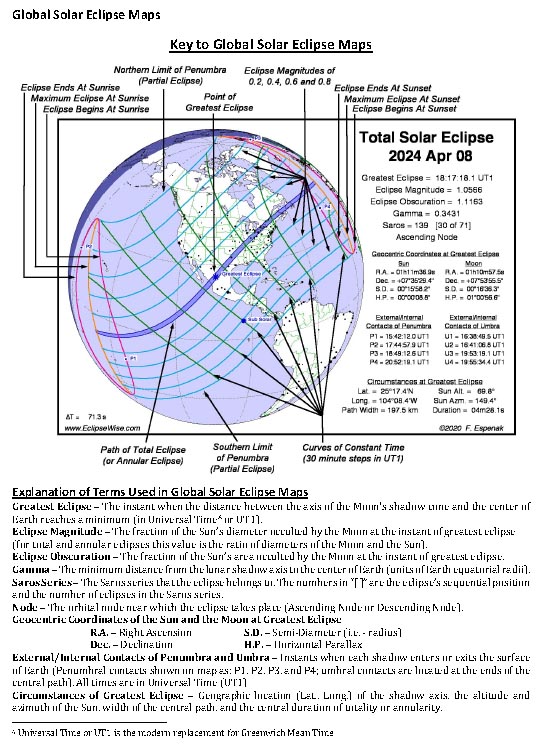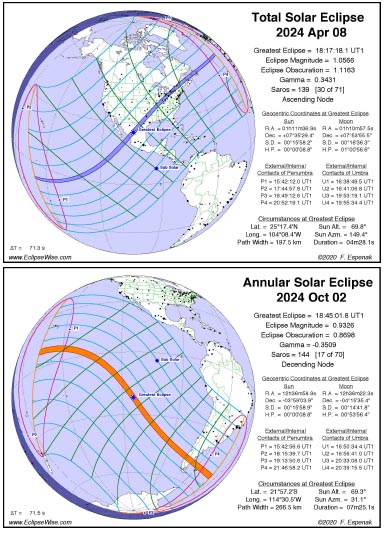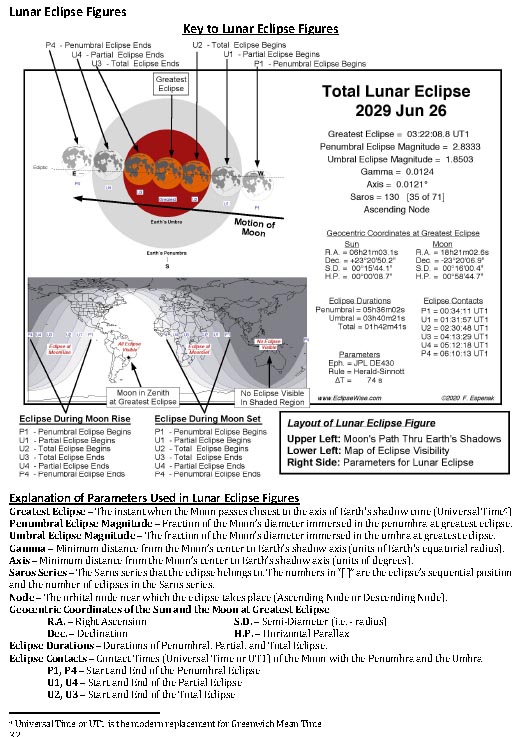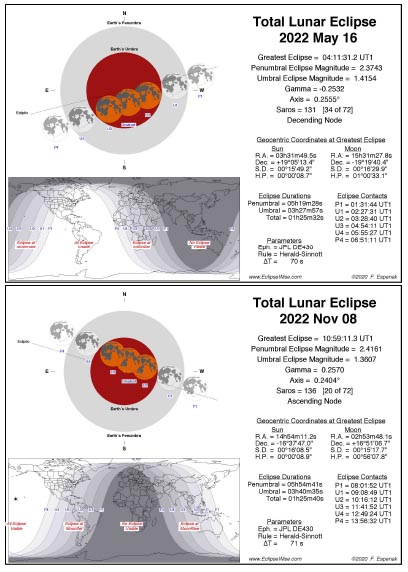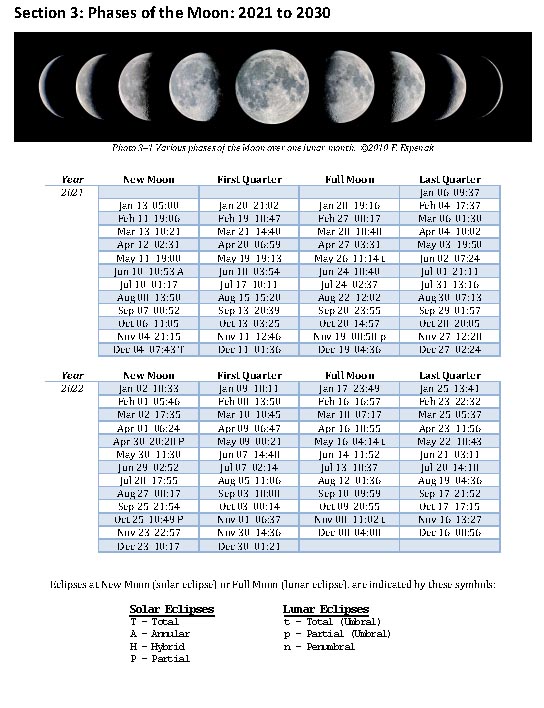Eclipse Almanac
The five volumes of the Eclipse Almanac publication series include maps and diagrams
of every solar and lunar eclipse from 2021 to 2070 (each volume covers a single decade).

The Eclipse Almanac is series of five publications.
Each one is a concise reference for every eclipse of the Sun and the Moon over a 10-year period.
This compendium identifies when and where each of these events will be seen.
Particular details about each eclipse are included, as well as a 25-year table looking further into the future.
Section 1 presents solar eclipses including an explanation of why they occur, types of solar eclipses (partial, annular, and total), and the visual appearance of each.
Global maps depict the geographic regions of visibility of each of the 22 to 23 solar eclipses.
Section 2 covers lunar eclipses with an explanation on why they occur, types of lunar eclipses (penumbral, partial, and total), and the visual appearance of each.
Detailed figures illustrate each of the 22 to 23 lunar eclipses including the Moon's path through Earth's shadows, and a map identifying the geographic regions of visibility of every eclipse.
Section 3 lists the date and time of the Moon’s phases over the decade.
New Moon and Full Moon phases coinciding with solar and lunar eclipses are identified.
The five volume Eclipse Almanac series covers the following decades:
- Eclipse Almanac 2021 to 2030
- Eclipse Almanac 2031 to 2040
- Eclipse Almanac 2041 to 2050
- Eclipse Almanac 2051 to 2060
- Eclipse Almanac 2061 to 2070
The eclipse predictions in the Eclipse Almanac rely on the Jet Propulsion Laboratory's DE430 -
the same computer ephemeris used to guide planetary spacecraft missions across the Solar System.
Additionally, the lunar eclipse predictions use a new and more precise model of Earth's elliptical shadow featured in the
21st Century Canon of Lunar Eclipses.
Eclipse Almanac: Sample Pages
Below are two sample pages from the Section 1: Solar Eclipses.
Click on each to open a full-resolution page in PDF format.
In Section 1, the solar eclipses for the decade are arranged two to a page.
This provides ample image scale to readily identify the regions of visibility of total, annular and partial eclipses.
Additional information includes the time of greatest eclipse, Saros series, eclipse magnitude, start and end times of the partial and central eclipses,
geographic coordinates of greatest eclipse, Sun's altitude and azimuth, central path width and central line duration.
Below are two sample pages from the Section 2: Lunar Eclipses, and one sample from Section 3: Phases of the Moon.
Click on each to open a full-resolution page in PDF format.
In Section 2, the lunar eclipses for the decade are arranged two eclipses per page.
The Moon's path through Earth's umbral and penumbral shadows is illustrated, and a world map identifies the regions of visibility of each eclipse.
Additional information includes the time of greatest eclipse, Saros series, umbral and penumbral eclipse magnitudes,
coordinates of the Sun and Moon at greatest eclipse,
the start and end times of penumbral, partial and total phases, and the duration of each phase.
The lunar eclipse predictions use a new and more precise model of Earth's elliptical shadow recently featured in the
21st Century Canon of Lunar Eclipses.
In Section 3 lists the Phases of the Moon (New Moon, First Quarter, Full Moon, and Last Quarter) for the decade through ten annual tables..
All listed times use Universal Time.
Each volume is available in a Color editon ($18.99) as well as a very economical Black & White edition ($13.99).
And now, the Eclipse Almanac is also available in a Kindle edition ($7.99).
The Kindel edition is optimized for tablets and phones, so you can bring them with you wherever you go.

Links for Ordering the Eclipse Almanac publications
The goal of the Eclipse Almanac series is to offer concise, accurate, and inexpensive guides to upcoming eclipses of the Sun and Moon.
Choose only the decade(s) you are interested in.
The new Kindle editions offer the option to carry the Eclipse Almanac on your tablet or phone.
Links for ordering the Black & White editions from Amazon.com:
Links for ordering the Color editions from Amazon.com:
Links for ordering the Kindle editions from Amazon.com:
The links above are for Amazon.com. However, you can order these books from any Amazon worldwide.
Visit any Amazon and enter the book title in Amazon's search window.
|
About the Author
Click the following link to read a brief biography on Fred Espenak.
Also Available...
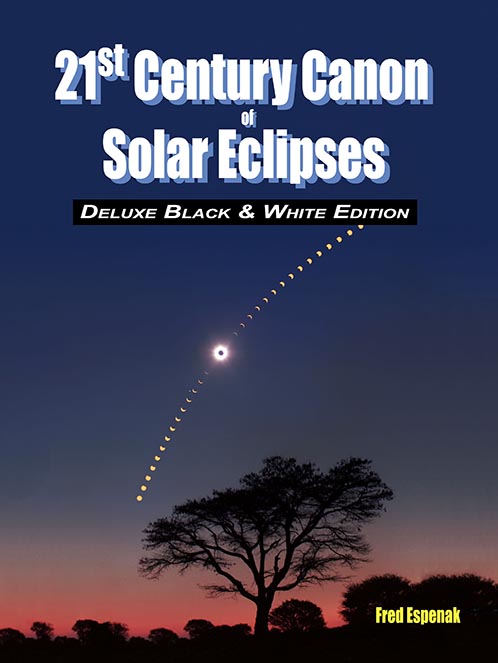
21st Century Canon of Solar Eclipses
The 21st Century Canon of Solar Eclipses contains maps and data for all 224 solar eclipses occurring during the 100-year period from 2001 through 2100.
The eclipse predictions are based on the Jet Propulsion Lab's DE405 - a computer ephemeris used for calculating high precision coordinates of the Sun and Moon for hundreds of years into the past and future.
Section 1 of the Canon presents the fundamentals about solar eclipses.
Section 2 discusses the eclipse the predictions, the constants used. A statistical analysis of eclipse frequency, extremes in eclipse magnitude, greatest central duration and quincena combinations are covered in Section 3. A concise explanation of the data contained in the solar eclipse catalog (Appendix A) and detailed descriptions of the solar eclipse maps.
The primary content of the "21st Century Canon" resides in the four appendices.
Appendix A is a comprehensive catalog of solar eclipses.
Appendix B is an atlas of maps (12 per page) depicting the geographic regions of visibility of each eclipse.
Appendix C zeros in on full-page maps each solar eclipse.
Curves of Maximum Time and Curves of Eclipse Magnitude permit the estimation of time and magnitude from any geographic location. Finally, Appendix D plots the track of every central eclipse (total, annular and hybrid) on large scale maps to allow the identification of countries and major cities within each eclipse path.
For more information visit 21st Century Canon of Solar Eclipses.
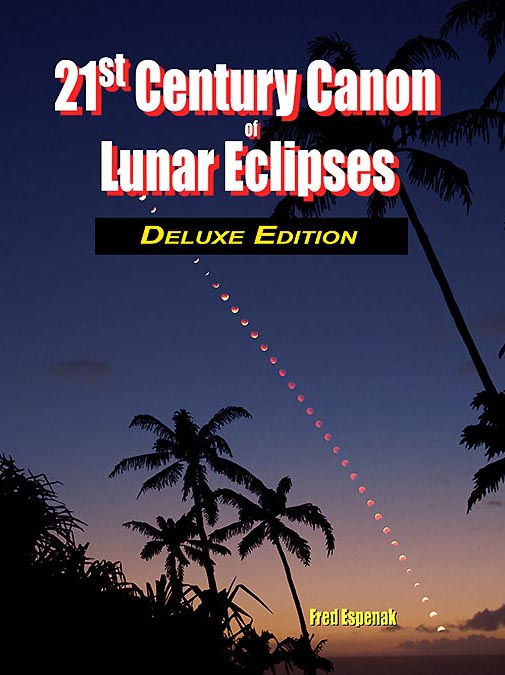
21st Century Canon of Lunar Eclipses
The 21st Century Canon of Lunar Eclipses contains figures, maps and data for all 228 lunar eclipses occurring during the 100-year period from 2001 through 2100.
The eclipse predictions are based on the Jet Propulsion Lab's DE431 - a computer ephemeris used for calculating high precision coordinates of the Sun and Moon for hundreds of years into the past and future.
Section 1 of the Canon presents the fundamentals about lunar eclipses.
Section 2 discusses the eclipse the predictions and the enlargement of Earth's shadows.
An analysis of eclipse frequency, and the extremes in penumbral and umbral eclipse magnitudes, and durations of penumbral, partial and total eclipses are covered in Section 3.
The primary content of the "21st Century Canon" resides in the three appendices.
Appendix A is a comprehensive catalog of lunar eclipses.
Appendix B is an atlas of diagrams (12 per page) depicting the Moon's path through Earth's shadows and the geographic region of visibility of each eclipse.
Appendix C zeros in on the lunar eclipses with a detailed full-page path diagrams and maps of each eclipse.
For more information visit 21st Century Canon of Lunar Eclipses.
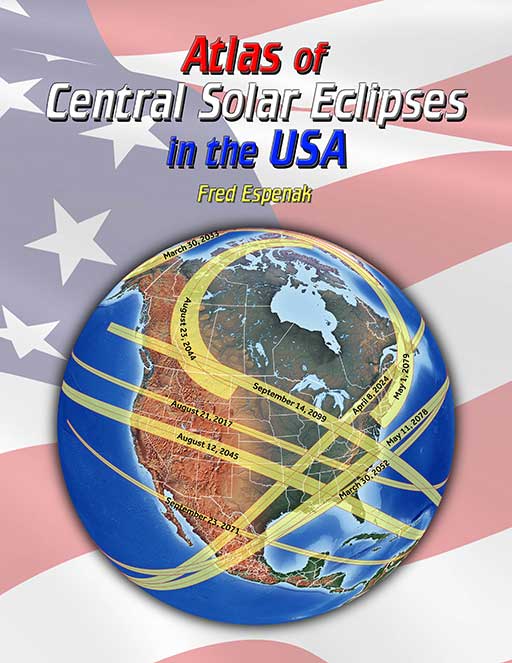
Atlas of Central Solar Eclipses in the USA
The Atlas of Central Solar Eclipses in the USA contains of a series of 499 global maps showing the geographic track of every total and annular solar eclipse across the USA (including Alaska and Hawaii) during the two-thousand-year period 1001 through 3000. It is accompanied by a catalog that lists the major characteristics of each eclipse including its duration and whether it is visible from the lower 48 states, Alaska and/or Hawaii.
A set of 20 detailed maps, each covering a 50-year period and centered on the lower 48 states, shows the path of every total and annular eclipse. The maps include state boundaries and major cities. These maps also cover southern Canada and northern Mexico.
For more information visit Atlas of Central Solar Eclipses in the USA.
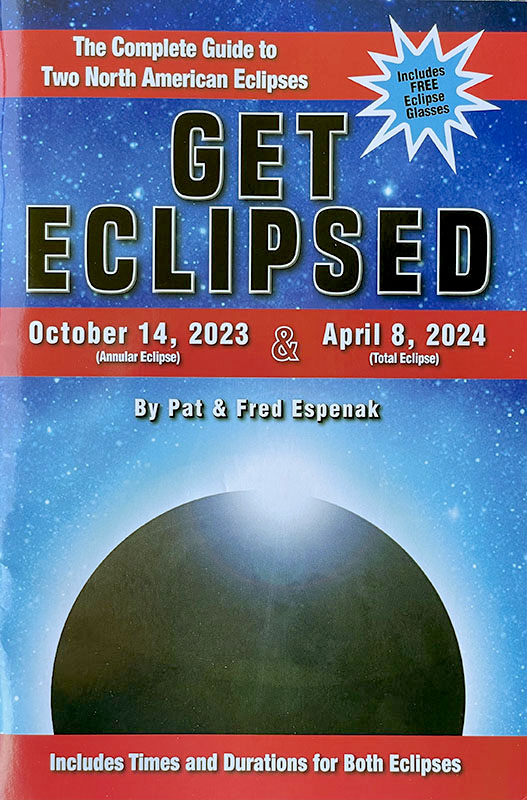
Get Eclipsed: A Family Guide to Two North American Eclipses
North America will be the scene for two spectacular eclipses of the Sun.
On October 14, 2023, an annular eclipse of the Sun occurs in western USA and Mexico.
Six months later, an incomparable total eclipse of the Sun occurs on April 8, 2024.
Its 125-mile wide path crosses Mexico, the USA from Texas to Maine, and eastern Canada.
During both of these events, a partial eclipse of the Sun will be visible from virtually all of North America.
The last annular eclipse visible from the USA was in 2012.
The last total eclipse visible from the USA was in 2017, and the next one to cross the country won't be until 2044.
Don't miss the incredible experience of seeing these celestial wonders!
Get Eclipsed is an easy to read, family friendly, inexpensive eclipse guide for the entire family.
It tells you everything you need to know about the upcoming annular and total eclipses of the Sun in 2023 and 2024.
And it comes with two pairs of special glasses for safely watching the partial eclipse phases and annularity.
For more information visit Get Eclipsed.
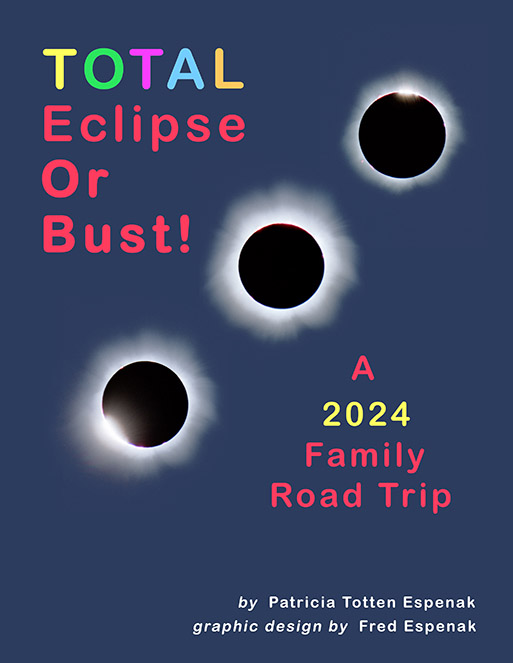
Total Eclipse or Bust! A 2024 Family Road Trip
TOTAL Eclipse or Bust! A 2024 Family Road Trip is a book for the entire family.
It explains the how and why of eclipses in an uncomplicated and friendly way.
It also provides basic information about how to view a total solar eclipse and where to go for America's eclipse on April 8, 2024.
This a great book for the whole family. If you're new to eclipses this book is for you!
For more information visit Total Eclipse or Bust! A 2024 Family Road Trip.
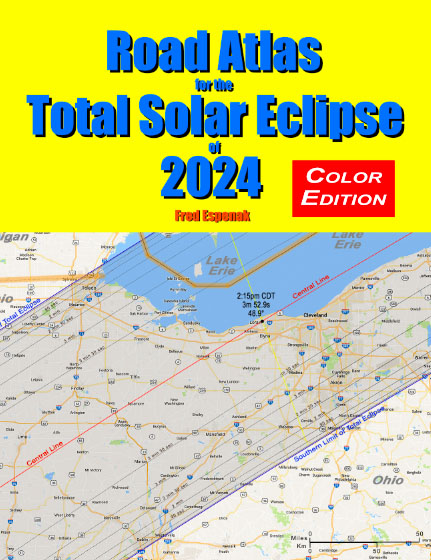
Road Atlas for the Total Solar Eclipse of 2024
The Road Atlas for the Total Solar Eclipse of 2024 is a complementary publication of the
2024 Eclipse Bulletin.
It contains a comprehensive series of 26 high resolution, full color maps of the path of totality across Mexico, the USA, and Canada.
The large scale (1:400,000 or 1 inch = 22 miles) shows both major and minor roads, towns and cities, rivers, parks, and mountains.
Armed with this atlas and the latest weather forecasts, the road warrior is ready to chase totality no matter where it takes him/her along the 2500-mile-long path.
This mobile strategy offers the highest probability of witnessing the spectacular 2024 total eclipse in clear skies.
For more information visit Road Atlas for the Total Solar Eclipse of 2024.
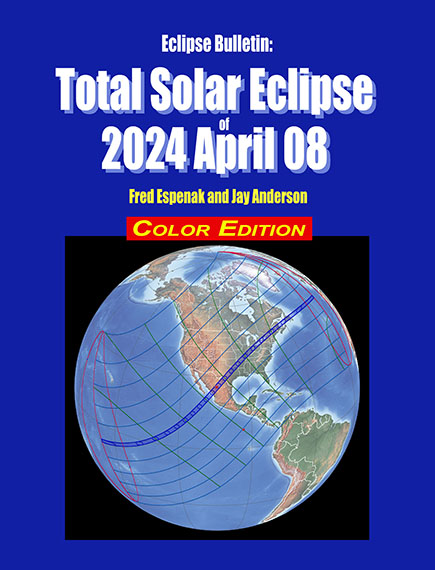
Eclipse Bulletin: Total Solar Eclipse of 2024 April 08
The Eclipse Bulletin: Total Solar Eclipse of 2024 April 08 is the complementary publication of the
2024 Road Atlas and is the ultimate guide to this highly anticipated event.
Eleven high resolution maps plot the total eclipse track across Mexico, the USA, and Canada.
The large map scale (1 inch ≈ 53 miles) shows hundreds of cities and towns in the path, the location of major roads and highways, and the duration of totality with distance from the central line.
Local circumstances tables for hundreds cities the USA, Canada, and Mexico provide times of each phase of the eclipse along with the eclipse magnitude, duration and Sun's altitude.
A detailed climatological study identifies areas along the eclipse path where the highest probability of favorable weather may be found.
Finally, comprehensive information is presented about solar filters and how to safely observe the eclipse.
For more information visit Eclipse Bulletin: Total Solar Eclipse of 2024 April 08.
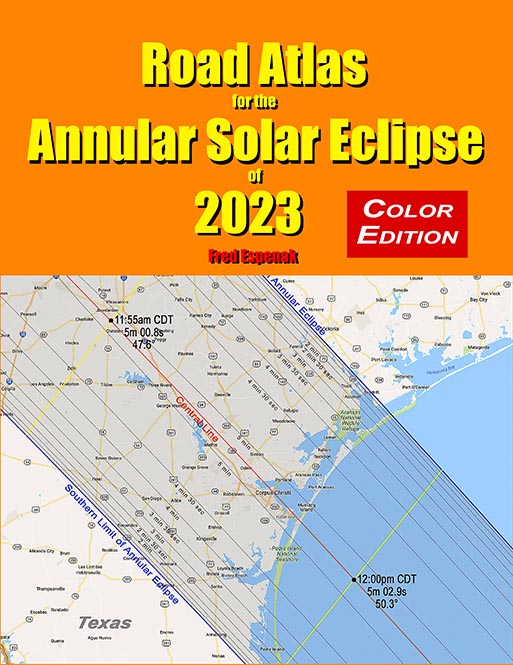
Road Atlas of the Annular Solar Eclipse of 2023
The Road Atlas for the Annular Solar Eclipse of 2023 contains a series of 29 maps of the path of annularity across the USA, Mexico, Central and South America.
The large scale (1 inch ≈ 28 miles) shows both major and minor roads, towns and cities, rivers, parks, and mountains.
The annular eclipse phase in which the Moon is completely silhouetted in front of the Sun (known as annularity) will only be seen from within the 115 to 137 mile-wide path of the Moon’s antumbral shadow
as it sweeps across the United States (Oregon, California, Idaho, Nevada, Utah, Colorado, Arizona, New Mexico, and Texas), Mexico, Central and South America.
Armed with this atlas and the latest weather forecasts, the road warrior is ready to chase annularity no matter where it takes him/her along the entire path.
This mobile strategy offers the highest probability of witnessing the amazing 2023 annular eclipse in clear skies.
For more information visit Road Atlas for the Annular Solar Eclipse of 2023.
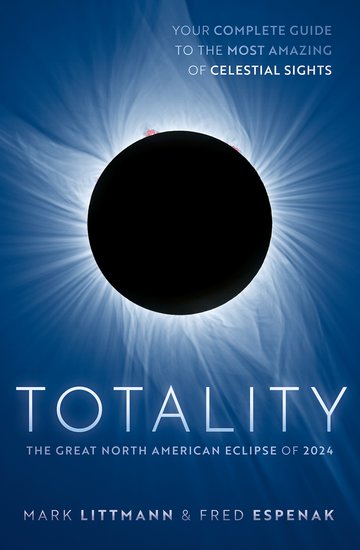
Eclipse Bulletin: Total Solar Eclipse of 2017 August 21
The Eclipse Bulletin: Total Solar Eclipse of 2017 August 21 is the complementary publication of the
2017 Road Atlas and is the ultimate guide to this highly anticipated event.
Local circumstances tables for more than 1000 cities across the USA provide times of each phase of the eclipse along with the eclipse magnitude, duration and Sun's altitude.
Additional tables cover the eclipse circumstances for cities in Canada, Mexico, Central and South America and Europe.
An exhaustive climatological study identifies areas along the eclipse path where the highest probability of favorable weather may be found.
A travelogue highlights key locations in the eclipse track from Oregon through South Carolina.
Finally, comprehensive information is presented about solar filters and how to safely observe and photograph the eclipse.
For more information visit Eclipse Bulletin: Total Solar Eclipse of 2017 August 21.

Totality - The Great North American Eclipse of 2024
The Totality - The Great North American Eclipse of 2024 is a complete guide to the spectacular total eclipse of April 8, 2024 that passes across the United States, Mexico and Canada.
The book provides information, photographs, and illustrations to help understand and safely enjoy all aspects of this eclipse including:
- How to observe a total eclipse of the Sun
- How to photograph and video record an eclipse
- Why solar eclipses happen
- The earliest attempts to understand and predict eclipses
- The mythology and folklore of eclipses
- The response of man to total eclipses through time
- How scientists used total eclipses to understand how the Sun works
- How astronomers used a total eclipse to confirm Einstein's general theory of relativity
- Weather prospects for the 2024 eclipse
- Detailed maps of the path of totality for the 2024 eclipse
- Precise local times for the 2024 eclipse (the next total solar eclipse to visit the U.S.)
- Color and black-and-white photographs, diagrams, and charts to illustrate and explain total solar eclipses
- Global maps of total solar eclipses from 2024 to 2045 and lists of total and annular solar eclipses from 1970 through 2070
For more information visit Totality - The Great North American Eclipse of 2024.

